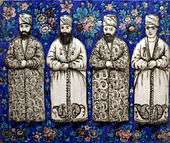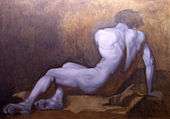Grisaille


Grisaille (/ɡrᵻˈzaɪ/ or /ɡrᵻˈzeɪl/; French: gris [ɡʁizaj] 'grey') is a term for a painting executed entirely in shades of grey or of another neutral greyish colour.[1] It is particularly used in large decorative schemes in imitation of sculpture. Many grisailles in fact include a slightly wider colour range, like the Andrea del Sarto fresco illustrated. Paintings executed in brown are referred to as brunaille, and paintings executed in green are called verdaille.[2]
A grisaille may be executed for its own sake, as underpainting for an oil painting (in preparation for glazing layers of colour over it), or as a model for an engraver to work from. "Rubens and his school sometimes use monochrome techniques in sketching compositions for engravers."[3] Full colouring of a subject makes many more demands of an artist, and working in grisaille was often chosen as being quicker and cheaper, although the effect was sometimes deliberately chosen for aesthetic reasons. Grisaille paintings resemble the drawings, normally in monochrome, that artists from the Renaissance on were trained to produce; like drawings they can also betray the hand of a less talented assistant more easily than a fully coloured painting.
History

Giotto used grisaille in the lower registers of his frescoes in the Scrovegni Chapel, and Robert Campin, Jan van Eyck and their successors painted grisaille figures on the outsides of the wings of triptychs, including the Ghent Altarpiece. Originally these were the sides on display for most of the time, as the doors were normally kept closed except on feast days or at the (paid) request of tourists. However today these images are often invisible in museums when the tryptych is displayed open and flat against a wall. In these cases imitation of sculpture was intended; sculpture was still more expensive than a painting even by a top master.
Illuminated manuscripts had often been produced in pen and wash with a very limited colour range, and many artists such as Jean Pucelle and Matthew Paris specialised in such work, which had been especially common in England since Anglo-Saxon times. Renaissance artists such as Mantegna and Polidoro da Caravaggio often used grisaille as a classicising effect, either in imitation of the effect of a classical sculptured relief, or of Roman painting.
In the Low Countries a continuous tradition of grisaille paintings can be traced from Early Netherlandish painting to Martin Heemskerck, Pieter Brueghel the Elder (Christ and the Woman Taken in Adultery) and Hendrik Goltzius, and through the copious output of Adriaen van de Venne, to the circle of Rembrandt, and Jan van Goyen.
The ceiling frescoes of the Sistine Chapel have portions of the design in grisaille, as does the lower part of the great staircase decoration by Antonio Verrio at Hampton Court.
Grisaille, while less widespread in the 20th century, continues as an artistic technique. Picasso's painting Guernica is one contemporary example.
Academic study
With the 20th century's emphasis on direct (alla prima) painting, the grisaille technique lost favour with artists of the period. This historic method is still incorporated into the curriculum of some private ateliers.[4]
In enamel and stained glass

The term is also applied to monochrome painting in other media such as enamels, where an effect similar to a relief in silver may be intended. It is common in stained glass, where the need for sections in different colours was thereby greatly reduced. Portions of a window may be done in grisaille — using, for example, silver stain or vitreous paint — while other sections are done in coloured glass.
Gallery
 Molded Tile, mid-19th century Iran. Brooklyn Museum
Molded Tile, mid-19th century Iran. Brooklyn Museum Master of Frankfurt, Saint Odile and Saint Cecilia, ca. 1503–1506, oil on panel, Historical museum, Frankfurt.
Master of Frankfurt, Saint Odile and Saint Cecilia, ca. 1503–1506, oil on panel, Historical museum, Frankfurt. Giotto, Scrovegni Chapel, Infidelity
Giotto, Scrovegni Chapel, Infidelity Andrea del Castagno, monument to Niccolò da Tolentino
Andrea del Castagno, monument to Niccolò da Tolentino
 Triptych shutter outside panel by Hieronymus Bosch
Triptych shutter outside panel by Hieronymus Bosch Frans Francken II by Anthony van Dyck, one of a series of studies for portrait prints
Frans Francken II by Anthony van Dyck, one of a series of studies for portrait prints
_-_Foto_Giovanni_Dall'Orto_20-May-2007.jpg) Italian palace staircase, 18th century
Italian palace staircase, 18th century Student copy in grisaille after Jacques-Louis David [5]
Student copy in grisaille after Jacques-Louis David [5] Painted Fire Screen by Jacques Vigoureux Duplessis. Pair of figures painted on the right side are in the Grisaille style. The Walters Art Museum.
Painted Fire Screen by Jacques Vigoureux Duplessis. Pair of figures painted on the right side are in the Grisaille style. The Walters Art Museum. Window of St. Peter: Stained glass (white glass, grisaille and silver sulfide) and lead, France, ca. 1500–1510
Window of St. Peter: Stained glass (white glass, grisaille and silver sulfide) and lead, France, ca. 1500–1510 Jean Auguste Dominique Ingres and his workshop, Odalisque in Grisaille
Jean Auguste Dominique Ingres and his workshop, Odalisque in Grisaille
See also
- Sepia tone (photography)
References and notes
- References
- Notes
- ↑ Chilvers, Ian (ed.), The Oxford Dictionary of Art, 3rd edition, Oxford University Press, 2004, p. 314
- ↑ Christie’s, Sale 1380, Old Master Paintings, lot 49, New York, Christie’s, 17 June 2004.
- ↑ Oxford Companion to Art. Ed. Harold Osborne; Clarendon Press. Oxford, 1970.
- ↑ For example, at The Contemporary Realist Academy, in Memphis, Tennessee, The Ryder Studio in Santa Fe, New Mexico and Ecole Albert Defois in France.
- ↑ Mims Studios School of Fine Art
External links
| Wikimedia Commons has media related to Grisaille. |
- (Metropolitan Museum of Art) Jan Gossart's Saint Jerome Penitent using grisaille
- (Metropolitan Museum of Art) Jean-Auguste-Dominique Ingres and workshop, Odalisque in Grisaille